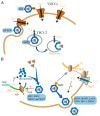Host Calcium Channels and Pumps in Viral Infections
- PMID: 31905994
- PMCID: PMC7016755
- DOI: 10.3390/cells9010094
Host Calcium Channels and Pumps in Viral Infections
Abstract
Ca2+ is essential for virus entry, viral gene replication, virion maturation, and release. The alteration of host cells Ca2+ homeostasis is one of the strategies that viruses use to modulate host cells signal transduction mechanisms in their favor. Host calcium-permeable channels and pumps (including voltage-gated calcium channels, store-operated channels, receptor-operated channels, transient receptor potential ion channels, and Ca2+-ATPase) mediate Ca2+ across the plasma membrane or subcellular organelles, modulating intracellular free Ca2+. Therefore, these Ca2+ channels or pumps present important aspects of viral pathogenesis and virus-host interaction. It has been reported that viruses hijack host calcium channels or pumps, disturbing the cellular homeostatic balance of Ca2+. Such a disturbance benefits virus lifecycles while inducing host cells' morbidity. Evidence has emerged that pharmacologically targeting the calcium channel or calcium release from the endoplasmic reticulum (ER) can obstruct virus lifecycles. Impeding virus-induced abnormal intracellular Ca2+ homeostasis is becoming a useful strategy in the development of potent antiviral drugs. In this present review, the recent identified cellular calcium channels and pumps as targets for virus attack are emphasized.
Keywords: antiviral; calcium channels; calcium pumps; virus; virus–host interaction.
Conflict of interest statement
The authors declare no conflict of interest.
Figures


References
-
- Martinez de Victoria E. Calcium, essential for health. Nutr. Hosp. 2016;33(Suppl. S4):341. - PubMed
Publication types
MeSH terms
Substances
LinkOut - more resources
Full Text Sources
Other Literature Sources
Medical
Miscellaneous

